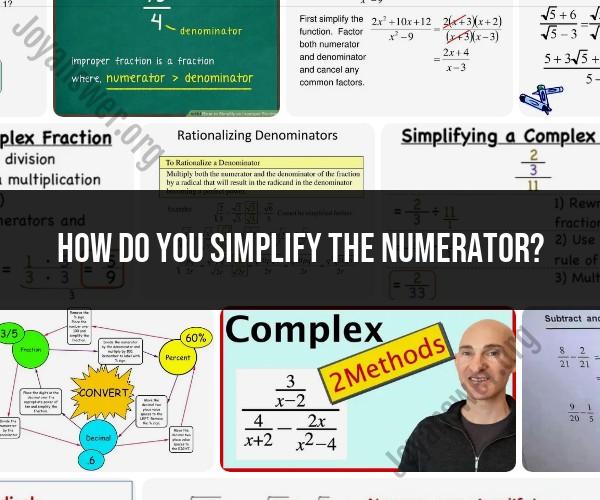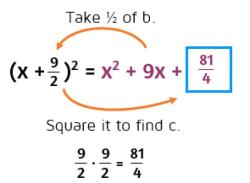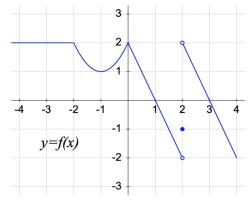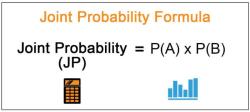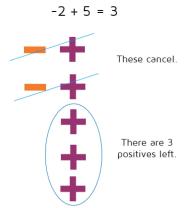How do you simplify the numerator?
Simplifying the numerator of a fraction involves reducing the numerator to its simplest form while maintaining the fraction's overall value. Here are some techniques for simplifying the numerator:
Factorization: One common technique is to factorize the numerator. This involves breaking down the numerator into its prime factors. Once you have the prime factors, you can look for common factors with the denominator to cancel them out.
For example, consider the fraction . You can factorize both the numerator and denominator:
Now, you can cancel out the common factor of 2:
Finally, you can simplify further by dividing both the numerator and denominator by their greatest common divisor (in this case, 5):
So, the simplified numerator is 2.
Using Common Factors: If you can identify common factors or multiples in the numerator, you can simplify directly. This is especially useful when the numerator is a polynomial.
For example, consider the fraction . You can simplify by recognizing the common factor of 6xy:
By canceling the common factor, you get:
So, the simplified numerator is 2x.
Using Laws of Exponents: When working with algebraic expressions or variables with exponents, you can simplify the numerator by applying the laws of exponents. For example, you can use the laws of multiplication, division, and powers to simplify expressions with exponents.
For instance, if you have , you can simplify it by subtracting the exponents:
So, the simplified numerator is x.
Substituting Values: Sometimes, simplifying the numerator involves substituting numerical values or simplifying algebraic expressions before performing the division. This is especially useful when dealing with complex expressions.
For example, if you have , you can simplify it by factoring the numerator, but you might also notice that can be factored as . This allows you to simplify the fraction as:
Depending on the context, you may choose different techniques to simplify the numerator, and it often depends on the specific expression or equation you're working with.
There are a number of ways to simplify the numerator of a fraction. Here are a few techniques:
- Factor the numerator. If the numerator can be factored, you can cancel out any common factors. For example, the numerator of the fraction 6/12 can be factored as 2 * 3. We can then cancel out the common factor of 2 to get the simplified fraction 3/6.
- Use the greatest common factor (GCD). The GCD of two numbers is the largest number that is a factor of both numbers. To find the GCD of two numbers, you can use the following steps:
- List out the factors of each number.
- Find the largest number that is on both lists.
- The largest number on both lists is the GCD of the two numbers.
Once you have found the GCD of the numerator and denominator, you can divide both the numerator and denominator by the GCD to simplify the fraction. For example, the GCD of the numerator and denominator of the fraction 12/18 is 6. We can then divide both the numerator and denominator by 6 to get the simplified fraction 2/3.
- Use the distributive property. The distributive property states that a(b + c) = ab + ac. This property can be used to simplify fractions by distributing the numerator over the denominator. For example, the fraction (2x + 3)/(x + 1) can be simplified using the distributive property as follows:
(2x + 3)/(x + 1) = (2x/(x + 1)) + (3/(x + 1)) = 2 + (3/(x + 1))
The simplified fraction is 2 + (3/(x + 1)).
- Use rationalization. Rationalization is the process of simplifying a fraction by getting rid of any radicals in the denominator. This is done by multiplying the numerator and denominator by a radical that will cancel out the radical in the denominator. For example, the fraction 1/√2 can be rationalized by multiplying the numerator and denominator by √2:
(1/√2) * (√2/√2) = √2/2
The radical in the denominator has now been canceled out, and we have a fraction with a rational denominator.
These are just a few techniques for simplifying the numerator of a fraction. The best technique to use will depend on the specific fraction that you are working with.
Here are some tips for simplifying the numerator:
- Always look for common factors to cancel out.
- Use the distributive property when possible.
- Rationalize the denominator if necessary.
- Use a calculator or computer algebra system to help you if you are having trouble.
Simplifying the numerator can make fractions easier to work with and can help you to solve math problems more efficiently.
